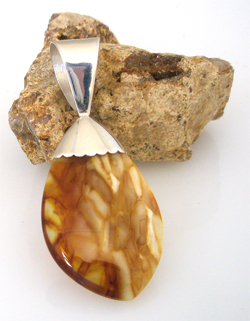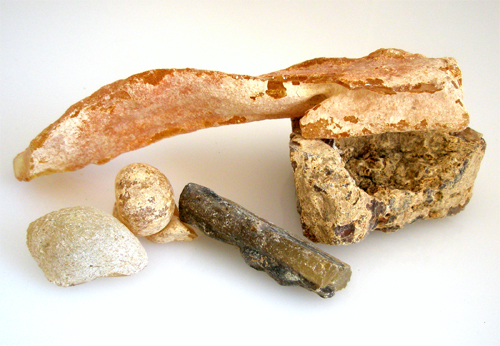 |
|
Amber Amber is fossilized, hardened pine resin or gum produced by some fossil plants and is appreciated for its color, beauty and extensive history. Amber itself can range from a whitish color through a pale lemon yellow, to brown and almost black. Other more uncommon colors include red amber or "cherry amber", green amber, and even blue amber, which is rare and highly sought after. A common misconception is that amber is made of tree sap. Sap is the fluid that circulates through a plant's vascular system, while resin is the semi-solid amorphous organic substance secreted through epithelial cells of the plant. Although not mineralized, it is often classified as a gemstone. Most amber is drop or nodular often with a weathered crust. It is often cloudy because of numerous bubbles and fine hair lines or tension fractures. Because it was once a soft and sticky tree resin, amber can have inclusions of insects and even small vertebrates. Semi-fossilized resin or sub-fossil amber is known as copal. Amber should be distinguished from copal. Molecular polymerisation caused by pressure and heat transforms the resin first into copal and then over time through the evaporation of turpines it is transformed into amber. Amber is used for beads and ornaments, and for cigar-holders and the mouth-pieces of pipes. It is regarded by the Turks as especially valuable, inasmuch as it is said to be incapable of transmitting infection as the pipe passes from mouth to mouth. The variety most valued in the East is the pale straw-colored, slightly cloudy amber. Some of the best qualities are sent to Vienna for the manufacture of smoking appliances. Amber is sensitive to acids, caustic solutions and gasoline as well as alcohol and perfume and can be dissolved by any of these solutions. Heating amber will soften it and eventually it will burn and produce incense. When rubbed with a cloth, amber becomes electrically charged and can attract small particles. It has a resinous luster when it is polished. It is possible to clear air bubbles and enclosed liquids from the material by boiling in rape-seed oil. Even though Amber is found throughout the world, the dominate sources for commercial use are found both in the Baltic and the Dominican Republic. Baltic amber is distinguished from the various other ambers from around the world due to it having succinic acid of which not other amber has. About 90% of the world's extractable amber is located in the Kaliningrad Oblast of Russia on the Baltic Sea. This amber is used to make sculptures, house hold items and jewelry. Dominican amber differentiates itself from Baltic amber by being mostly transparent and often containing a higher number of fossil inclusions. In contrast to Baltic amber, Dominican amber found on the world market is natural amber the way it comes from the mines, and has not been enhanced or received any chemical or physical change. All Dominican amber is fluorescent with the rarest being blue amber. The most common use for Dominican amber is as ornaments and jewelry, while the more valuable enclosures and colorations become priced exhibition pieces both in private and public collections. Amber is like a time capsule made and placed in the earth by Mother Nature herself. More than 1000 extinct insects’ species have been identified in amber. The oldest amber originates from the Upper Carboniferous period approximately 345 million years ago. The oldest known amber containing insects comes from the Lower Cretaceous, approximately 146 million years ago. The earliest recorded fossil resins are of the Carboniferous age, but ambers do not occur until the early Cretaceous. Amber from the Baltic Sea has been extensively traded since antiquity and in the main land, from where amber was traded 2000 years ago. Amber has been used since prehistoric times for jewelry and religious objects accessories for smokers also as amulets and mascots. The Baltic amber, the gold of the north, is among the earliest-used gem materials. Amber was much valued as an ornamental material in very early times. It has been found in Mycenaean tombs; it is known from lake-dwellings in Switzerland, and it occurs with Neolithic remains in Denmark, whilst in England it is found with interments of the Bronze Age. The so-called Hove amber cup, a cup turned in amber from a bronze-age barrow at Hove is now in the Brighton Museum. Beads of amber are found with Anglo-Saxon relics in the south of England. Amber was valued as an amulet and it is still believed to possess medicinal properties. The Amber Room was a collection of chamber wall panels commissioned in 1701 for the King of Prussia, and then given to Tsar Peter the Great. The room was hidden in place from invading Nazi forces it in the Catherine Palace, disassembled it and moved it to Königsberg. What happened to the room beyond this point is unclear, but it may have been destroyed when the Russians burned the German fortification where it was stored. It is presumed lost. It was re-created in 2003. Amber allows the body to heal itself by absorbing and transmuting negative energy into positive energy. It emits a sunny and bright soothing energy which helps to calm nerves and to enliven the disposition. It also provides energy to kindle the realization and subsequent response of choice, helping one to choose and to be chosen. It has been used as a symbol for renewal of marriage vows and to assure promises. It has been said to bring good luck to warriors. Amber also stimulates the intellect. |
|
|
Desert Rosing Trading. All Rights Reserved.


